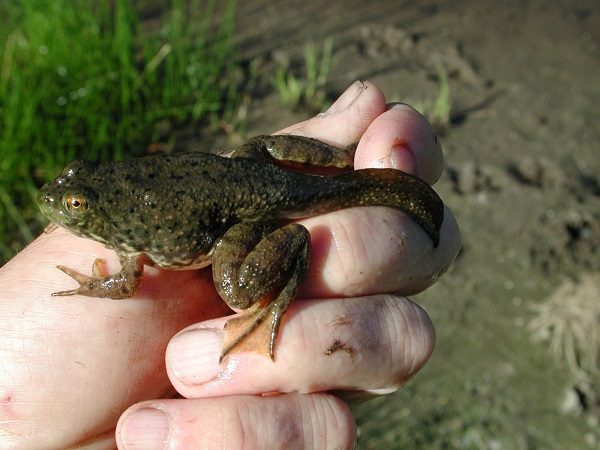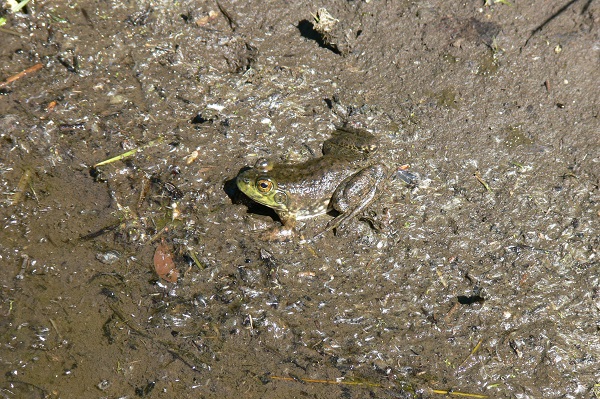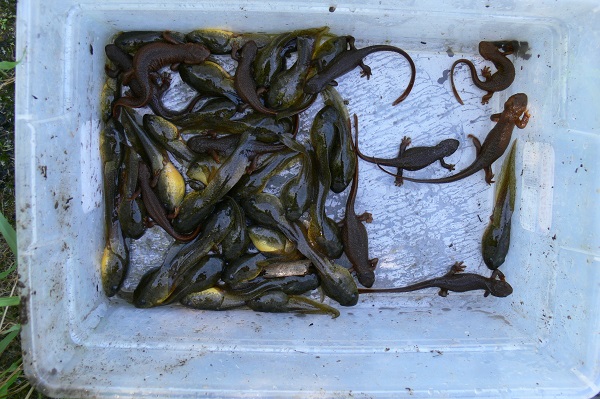written by: Gary Shugart (introduction by Kathryn True)
The red-legged frogs have laid their eggs and the Pacific tree frogs are in full chorus. But what are the bullfrogs up to? At the height of summer, they will lay their frothy sheets of eggs (described as looking like poppy seeds scattered on slime) on the warm water surface. These southerners (imported west for their tasty legs), prefer warm and sunny permanent ponds. Their tadpoles take two years to morph into adults, so the young die off if they hatch in ephemeral ponds. Islander Gary Shugart, curator of the Slater Museum of Natural History at the University of Puget Sound in Tacoma, shared this perspective on bullfrogs’ bad rap as horrible invasive animals to be blamed for native amphibian loss. Though this piece was last updated in 2008, the information remains pertinent, with the main change being that there are now more permanent ponds (conducive to bullfrog rearing) on the island.
Bullfrogs were introduced to the Pacific NW in the 1920-40s for frog-leg farms, pond features, and for hunting. Since their introduction they have spread throughout Washington to most lowland permanent water bodies. On Vashon, several years ago I asked on Ed Swan’s email list if anyone knew of any other bullfrogs in residence besides the region of Island Center Mukai/Fisher Pond and surrounding ponds. Responses indicated they were spread throughout the island and had been here for at least 50 years.
In many ecological circles and the popular press, bullfrogs are viewed as the incarnate of evil because they can eat native species of amphibians and reptiles, overwhelm ponds with tadpoles and even put small pets and children in danger (just kidding on the last two). An alternative view is that bullfrogs are the manifestation of human alteration of natural systems and coincidently occur in ponds where native species would not occur or would have been decimated by human alteration of habitat. The first view seems a forgone conclusion, but, there are surprisingly few scientific studies from which sweeping generalizations have been made.
A review of the “bullfrog problem” by Marc Hayes, now a research scientist with the WDFW, and Marc Jennings, generally supports the alternative view and implicates introduced predatory fish as the unseen problem. Non-native fish usually co-occur in “bullfrog ponds”, which are human-created permanent warm water ponds, and fish are more significant factors than bullfrogs per se. More importantly the attention on the obvious and visible bullfrogs has directed time and resources toward bullfrog control and diverted attention from the more critical world-wide decline in amphibians which are occurring in many areas in the absence of bullfrogs.
To assess the severity of the bullfrog problem, some natural history is helpful. Bullfrogs are native to eastern North America where they evolved in systems dominated by fish predators. They can undergo metamorphosis in less than a year in the warm south but take more than one year in colder northern clines such as Vashon. After metamorphosis, which is the change from tadpoles into frogs, they take two or more years to reach sexual maturity. Females are larger than males and the largest can grow to eight or more inches (sitting), which is 2-3 times larger than closely related northwest natives: the red-legged, spotted, and Cascade frogs. The ubiquitous Pacific tree frogs are bite-size to an adult bullfrog. Other life history characteristics that appear to pre-adapt bullfrogs as invaders include massive clutches of eggs with resulting large cohorts of tadpoles in comparison to native species, and predatory juveniles and adults that eat anything that moves and can fit into their maw. In this respect, they are no different than native frogs except that bullfrogs grow larger and are able to consume larger prey.
Bullfrog tadpoles are also distasteful to some predatory fish, but contrary to popular accounts, this conclusion has not been tested on non-fish predators. In invasive situations, this character might be important because they often co-occur with introduced fish, the fish may avoid the bullfrog tadpoles. Bullfrog tadpoles also are able to live in turbid muddy water at low oxygen concentrations and relative high temperatures, which might give them an advantage in less than pristine ponds.
An extreme example of a system seemingly overwhelmed by bullfrogs was Island Center’s Mukai Pond. In mid-summer, the surface of the ponds shimmered earthquake-like when approached as the tadpoles in shallows fled to the depths. In seeing this phenomenon, one couldn’t help but wonder how many were in there? I attempted an estimate in July 2004 by sampling two ponds that were approximately 50 x 10 m and 80 x 20 m. I estimated a minimum 5,225 tadpoles were present and they ranged in size from 6-11 cm. This was in less than knee-deep muddy water. Similar numbers were present in 2005 and 2006. Typically, I scooped up 100+ tadpoles with an 18” diameter smelt net in each transect across a pond.
This is an extreme example of a human created permanent warm water pond that appears to be dominated by bullfrogs. In the mud of Mukai, through September with little rain and no inflow, mortality is high as the tadpoles are stranded or the concentration in the shrinking ponds attracts great-blue herons, belted kingfishers, mergansers, greater yellow-legs, ravens, and crows and raccoons. (The mud is a fantastic blackboard for tracking, learning and identifying the species.) I repeated transects in September 2004 and found fewer than 1,000 tadpoles remained. Of these, about 5% were four-legged metamorphs, which were tadpoles that over wintered and could leave the pond at any time. The rains came, filled the ponds, and any survivors would over winter and likely metamorphose in the following years providing the pond was deep enough to protect them from freezing.
A first impression when seeing a pond like Mukai was that bullfrogs had taken over the pond, but further investigation with surveys and sampling done in 2006-2007 indicate that there are substantial populations of native amphibians, especially long-toed salamanders, Northwestern salamanders, rough-skinned newts, Pacific tree frogs, and northern red-legged frog co-occurring with bullfrogs in good numbers in all but Meadow Lake. Meadow Lake has black crappie as does Fisher Pond. The latter also has golden shiners, the third such occurrence in the state, and large-mouthed bass. The crappie and bass are the unseen invasive predators lurking beneath the surface that Hayes and Jennings suggested were the actual problem in bullfrog ponds. The conundrum here is that the native species, at least on Vashon, appear to have coexisted or persisted for the past 30-50 years in the presence of the bullfrogs.
This is supported by published studies from Puget Sound lowlands, especially one by Adams, who found no consistent bullfrog impacts but, instead, implications that introduced fish were responsible for native amphibian declines. This apparent coexistence could reflect differences in ecology of the bullfrogs and the natives. Bullfrogs thrive in permanent warm-water ponds while NW natives appear to be adapted to colder ephemeral ponds. Many adults of the native species are out of ponds by the time bullfrogs are active. Thus the popular notion that bullfrogs are decimating adult populations of native species is inaccurate simply because they don’t co-occur in time. However, the aquatic larvae of native species are at risk from predation by adult and juvenile bullfrogs and larvae might compete with bullfrog tadpoles for food (red-legged and Pacific tree frogs). Adult newts and Northwestern salamander larvae are predacious and likely eat more bullfrog tadpoles than vice versa. In ponds with bullfrogs, bullfrog tadpoles are likely primary prey items of bullfrogs.
If bullfrogs are not gobbling up NW natives, are there other ways impacts might manifest? The search continues for a mechanism involving tadpoles. A likely interaction is scramble competition for resources. In bullfrogs, intraspecies competition is important in determining growth rates and size at metamorphosis. To extrapolate to nature and between species competition, again, natural history adds some perspective. When native larvae emerge early in the year, bullfrog tadpoles are represented by those from the previous summer, which are 2-4” in total length, and a few from two or more summers before, which can reach be up to 6” in length. Bullfrog tadpoles of the current year hatch during June-August and aren’t a factor.

The question is then, are there enough over wintering bullfrog tadpoles in ponds to affect natives? One study of the hills yellow-legged frog, from northern California, demonstrated that competition could reduce mobility and decrease growth rates which could reduce the size at metamorphosis or prolong the larval stage. Spotted frogs and the California red-legged frogs, which have habitat requirements more similar to bullfrogs than NW natives, also seem to be affected. One study in experimental ponds, by Andy Blaustein of Oregon State, found a clear affect from bullfrogs on California red-legged frogs when food was clumped, but absolutely no affect with non-clumped food. Enigmatically he went on to conclude that “this” was the mechanism that bullfrog impacts are manifest although the food in natural ponds tends toward non-clumped distribution unlike the fish food in the experimental ponds. The logic is a bit circular and may simply demonstrate that experiments can be set up to produce results.
In the same paper, Blaustein suggested that larger bullfrog tadpoles might eat small natives and this has now been picked up on websites as a fact. In the NW many of the ponds with bullfrogs are human-made warm water ponds created for storm water retention, wetlands mediation, landscaping, irrigation, and livestock watering. New examples include recently constructed permanent retention ponds at Island Lumber, Chautauqua Elementary, co-housing and south of Vashon, which all seemed to have had bullfrogs as chief engineers. These perfect bullfrog ponds provide more points in the matrix of ponds that promote the invasion of the landscape by bullfrogs. They are permanent and were colonized by bullfrogs, as well as tree frogs, in the first year.
From a perspective of native amphibians, most of these warm-water “bullfrog” ponds are as new to the island as are the humans that created them. In examining the area around Fisher Pond with Google Earth, I found over 40 of these ponds within 1 mile of Fisher Pond. Most of these permanent ponds are novel habitat for native species and it is unknown if there are fewer, the same, or more of the natives than prior to creation of permanent pond habitats. Thus, the bullfrog “invasion” in areas of the NW such as Vashon is not an invasion of native habitat but infilling of newly created warm water pond habitat (or niches) provided by humans.
Viewed this way, bullfrogs are then a manifestation of human alteration of the landscape. Attempts at control lead to an ecological incongruity reflected in the title of this article; the “Us” being humans and our ecological whims. Something I contemplate when looking at a bullfrog. They serve as a reminder of human influence on ecosystems and incongruent view of ecology with selectively acceptance of some features, such as warm water permanent ponds, however unnatural, but intolerance of other features such as bullfrogs. It makes about as much sense ecologically as viewing the spread of lawns and lawn grass as the cause to the decline in native plant species.
The need for permanent water is one aspect of bullfrog life history that could be used to affect a control. They are able to survive in fairly turbid oxygen poor conditions, nearly mud, but draining and drying ponds has been recommended as a control measure. Thus, if bullfrogs needed to be controlled, the obvious control measure is to return the water courses to the native ephemeral condition, akin to breaching the dams in the salmon wars. This would also eliminate the introduced fish species, which are suspected as being a more significant problem than bullfrogs. Before draining, ponds should be checked for NW salamanders which also over winter. However, I can’t imagine that ponds like Fisher, Meadow Lake, Christensen or Mukai would be returned to a natural state because we love our unnatural ponds, for the unnatural diversity they add to biotic systems and plots of land.
Other control measures include removal of breeding adults, eggs masses, or both. Control efforts during 2006-2007 appear to have been successful in removing the largest bullfrogs from Fisher and Mukai Ponds and Meadow Lake. Bullfrogs will breed at a younger age in the absence of large older adults so it is unlikely they could ever be exterminated, but bullfrogs are smaller. Thus, if predation and competition by bullfrogs is a problem, then removal of large adults reduces the potential prey size that bullfrogs could be swallowed (pets and children will be safe), makes existing breeding bullfrogs more vulnerable as prey, and smaller frogs do not have the reproductive capacity of larger frogs, thus the population growth rate should be reduced.
At a global level, bullfrogs have now been introduced to Japan, China, and Europe and South America. In focusing on bullfrogs, the danger is that we ignore the global declines of native species that have been documented. Causes are unclear as yet, but several factors have been identified include increased UV-B radiation due to ozone loss, parasites, diseases, as well as introduction of competing species such as fish and bullfrogs. In the tropics, chytrid fungal disease, which is devastating to some tropical amphibians, has apparently been introduced along with bullfrogs imported for farming and the pet trade. It appears that many non-tropical amphibians are immune to the disease but are carriers. In addition to bullfrogs, tree frogs are immune as appears to be the case for most frogs closely related to bullfrogs (Ranid frogs, which includes red-legged, spotted and Cascade frogs). However, the fungal disease has been implicated in decline of Western toads. Bullfrog populations in western North America have run contrary to the global trend in amphibian declines and investigations of their success might also provide some important clues into the world-wide declines of other species.
Author: Gary Shugart, Ph.D. in Ecology, Slater Museum of Natural History, University of Puget Sound, gshugart@ups.edu. Originally written in 2006, updated July 2008.


